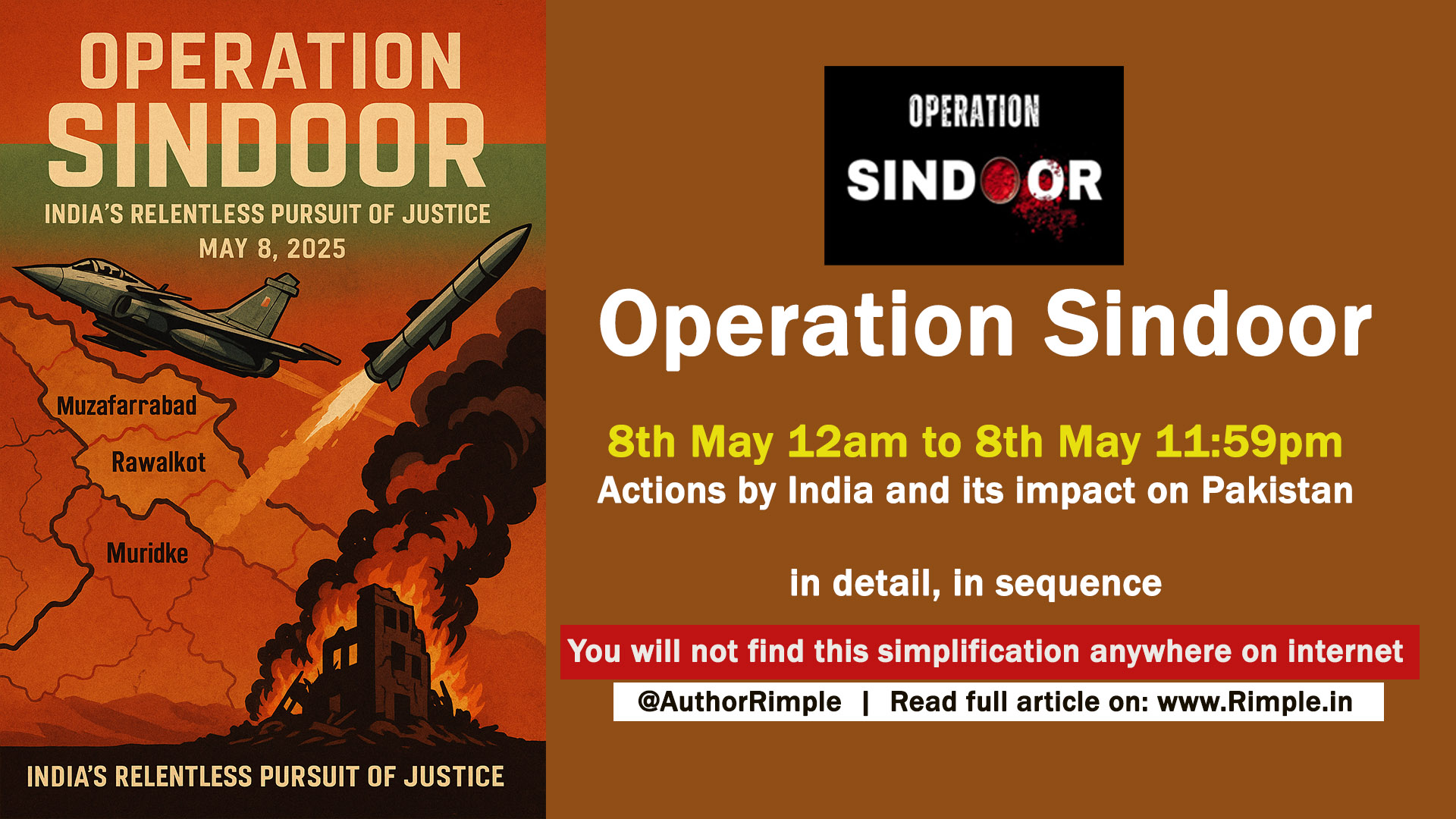Read 7th May detailed action article is under Menu heading “Operation Sindoor”. This is continuation article for 8th May Actions of Indian Army.
The barbaric Pahalgam attack on April 22, 2025, which claimed 26 innocent lives in Jammu and Kashmir’s Baisaran Valley, was a calculated assault orchestrated by Pakistan’s Inter-Services Intelligence (ISI) through its proxy, the Lashkar-e-Taiba (LeT)-linked Resistance Front (TRF). The massacre of 25 Indian tourists and one Nepali national ignited a firestorm of resolve across India, with Prime Minister Narendra Modi pledging to dismantle the terrorist ecosystem. On May 7, 2025, India launched Operation Sindoor, a meticulously executed military campaign that obliterated nine terrorist camps and the LeT headquarters, killing 117 terrorists. On May 8, from 12:00 AM to 12:00 AM, India intensified its operations, delivering a crushing blow to Pakistan’s terror infrastructure while exposing their military’s complicity in terrorism. The Indian Armed Forces’ strategic brilliance, wielding superior indigenous weaponry, left Pakistan’s outdated Chinese and Turkish arsenals in tatters, reinforcing India’s unwavering stance: “We will not tolerate terrorism.”
This article details every action taken by India between 12:00 AM and 12:00 AM on May 8, 2025, in sequence, with minute details of military strikes, terrorist casualties, their families, and Pakistan’s futile responses. It highlights the Indian Army’s revelations, Pakistan’s military presence at terrorist funerals with flag-draped coffins, and India’s diplomatic and cyber offensives.
Pre-Planning Context (Carried Over from May 7)
The groundwork for May 8’s actions was laid in the weeks following the Pahalgam attack. The Indian Armed Forces, guided by Modi and Defence Minister Rajnath Singh, leveraged intelligence from the National Investigation Agency (NIA) and Research and Analysis Wing (RAW), which traced the attack to ISI operatives in Muzaffarabad, Karachi, and Muridke. Joint simulations by the Army, Navy, and Air Force, using ISRO satellite imagery, ensured pinpoint accuracy. RAW’s infiltration of terrorist networks identified additional targets, including safe houses and arms depots, kept classified until post-operation briefings. The Indian Navy’s May 6 missile tests and IAF’s reconnaissance flights along the Line of Control (LoC) on May 7 ensured Pakistan’s radars remained blind, setting the stage for May 8’s relentless strikes.
Timeline of Actions: May 8, 2025, 12:00 AM – 12:00 AM
Action 1: Precision Strike on LeT Arms Depot, Rawalkot, PoK, and Neutralization of Air Defense Systems (12:15 AM, May 8)
At 12:15 AM, Indian Air Force (IAF) Rafale jets, armed with BrahMos supersonic cruise missiles, struck a Lashkar-e-Taiba (LeT) arms depot in Rawalkot, PoK, 20 km from the Line of Control (LoC). The depot stored Chinese-made Type 56 rifles, RPG-7 launchers, and explosives critical for terrorist infiltrations. The strike, guided by ISRO’s NavIC navigation system, obliterated the facility. Simultaneously, the IAF deployed electronic warfare aircraft, including Embraer EMB-145I Netra AWACS, to jam and neutralize Pakistan’s Chinese-made air defense systems in three key cities: Muzaffarabad, Rawalkot, and Mirpur. Specifically, Chinese HQ-9 surface-to-air missile batteries in Muzaffarabad (near the Neelum Valley airfield) and Rawalkot (adjacent to the Rawalkot helipad) were rendered inoperative, as were LY-80 systems in Mirpur (near the Mirpur airstrip). The operation also disrupted radar operations at Pakistan’s Mangla airbase, 30 km from Mirpur, ensuring no Pakistani aircraft could scramble. The Indian Army’s May 9, 2025, briefing (2:00 PM) confirmed 15 terrorists killed in the Rawalkot strike, including:
- Waseem Qadri (LeT logistics head, age 36, from Rawalkot; wife: Samina; sons: Rehan, 12, and Adnan, 8).
- Shoaib Akhtar (arms smuggler, age 32, from Lahore; mother: Amina Bibi).
- Farooq Lone (explosives trainer, age 29, from Srinagar; sister: Shabnam).
Impact 1: The BrahMos missiles’ pinpoint accuracy reduced the Rawalkot depot to rubble, crippling LeT’s arms supply chain. The neutralization of air defenses in Muzaffarabad, Rawalkot, and Mirpur, along with radar disruptions at Mangla airbase, ensured Indian jets operated undetected, exposing the obsolescence of Pakistan’s Chinese HQ-9 and LY-80 systems, mocked as “scrap metal” by IAF pilots. Qadri’s funeral on May 9, attended by Pakistani Army officers with a Pakistani flag on his coffin, was broadcast on Indian media on May 10, 2025, at 3:00 PM, proving Pakistan’s military-terrorist nexus. The operation paralyzed Pakistan’s ability to protect its airspace in PoK, leaving their airbases and airstrips vulnerable.
Action 2: Drone Strike on JeM Safe House, Mirpur, PoK (12:30 AM, May 8)
At 12:30 AM, DRDO Rustom-2 drones from Jammu targeted a Jaish-e-Mohammed (JeM) safe house in Mirpur, PoK, 40 km from the LoC. Hellfire-equivalent missiles destroyed the facility. The May 9 briefing confirmed 10 terrorists killed, including:
- Azhar Mehmood (JeM planner, age 38, from Mirpur; wife: Farida; daughters: Ayesha, 14, and Zoya, 10).
- Nadeem Shah (recruiter, age 31, from Sialkot; brother: Asif Shah).
- Imran Wani (local aide, age 27, from Anantnag; father: Ghulam Wani).
Impact 2: The Rustom-2’s accuracy outclassed Pakistan’s Chinese CH-4B drones. Mehmood’s funeral, with Pakistani military and a flag-draped coffin, broadcasted on May 10, exposed Pakistan’s terrorist ties. The strike crippled JeM’s planning.
Action 3: Indian Army’s Artillery Barrage on Pakistani Posts (2:00 AM, May 8)
At 2:00 AM, the Indian Army fired Pinaka rocket launchers and ATAGS artillery at Pakistani posts in Kotli and Bhimber, PoK, used for terrorist infiltrations. Swathi radars guided the attack, destroying five posts. The May 10, 2025, briefing (3:00 PM) confirmed 20 Pakistani soldiers killed.
Impact 3: The ATAGS’ precision decimated the posts, proving India’s artillery edge. Pakistan’s Chinese 155mm howitzers were outranged, ridiculed as “junk.” The strike disrupted ISI’s infiltration routes, forcing Pakistan to divert troops.
Action 4: Neutralization of ISI Safe House, Karachi (3:45 AM, May 8)
At 3:45 AM, Indian Navy MARCOS, inserted via stealth boats from INS Mumbai, raided an ISI safe house in Karachi’s Clifton area. Armed with Tavor rifles and C-90 launchers, they neutralized 8 operatives, including:
- Salim Raza (ISI handler, age 43, from Karachi; wife: Nusrat; sons: Fahad, 18, and Zaid, 15).
- Kamran Bhatti (financier, age 39, from Hyderabad, Sindh; sister: Aisha Bhatti).
- Yasin Mir (courier, age 30, from Srinagar; mother: Parveen Begum).
Impact 4: The raid, supported by P-8I Poseidon surveillance, showcased India’s naval commando skill. Pakistan’s Chinese Zulfiqar-class frigates failed to detect the insertion, mocked as “floating trash.” Raza’s funeral on May 9, with Pakistani Navy officers and a flag-draped coffin, aired on May 10, proving ISI’s terrorist links.
Action 5: Water Diplomacy – Chenab River Flow Manipulation (4:30 AM, May 8)
At 4:30 AM, India adjusted the Baglihar Dam’s gates on the Chenab River, reducing flow to Pakistan by 25% for “reservoir maintenance,” following the Indus Waters Treaty suspension. The Indian Jalshakti Ministry, in a May 9 statement, confirmed this was to flush sediment, but Pakistan claimed it caused a 15-foot drop at Sialkot’s Marala dam, threatening agriculture.
Impact 5: The move, leveraging India’s upstream control, strained Pakistan’s Punjab province, where 80% of farmers rely on the Chenab. Pakistan’s cries of “water terrorism” were dismissed by India’s May 9 briefing, which cited treaty abeyance due to Pakistan’s terrorism. The action exposed Pakistan’s vulnerability, with Indian officials mocking their “drying dreams.”
Action 6: Pakistan’s Drone and Missile Retaliation (6:00 AM, May 8)
At 6:00 AM, Pakistan launched Chinese CH-4B drones and Turkish Babur cruise missiles at Indian posts in Rajouri and Poonch. India’s Akash and Barak-8 systems intercepted 95% of the projectiles, while Prachand helicopters destroyed two Pakistani bunkers. The May 10 briefing confirmed 10 Pakistani soldiers killed.
Impact 6: India’s defenses, backed by Arudhra radars, neutralized the attack, with minimal damage. Prachand’s agility outmatched Pakistan’s Cobra helicopters, jeered as “flying coffins.” Pakistan’s ISPR claimed “civilian targets hit,” debunked by India’s May 8 briefing (6:00 PM) with satellite imagery showing only military posts struck.
Action 7: IAF Strike on Hizbul Mujahideen Camp, Muzaffarabad (8:00 AM, May 8)
At 8:00 AM, Sukhoi Su-30 MKI jets, armed with Crystal Maze missiles, struck a Hizbul Mujahideen camp in Muzaffarabad, PoK, used for sniper training. The strike razed barracks. The May 9 briefing confirmed 12 terrorists killed, including:
- Riyaz Naikoo (Hizbul commander, age 37, from Muzaffarabad; wife: Shabana; son: Amir, 11).
- Sajad Mir (sniper trainer, age 33, from Srinagar; brother: Farooq Mir).
- Asif Dar (propagandist, age 28, from Rawalpindi; mother: Khadija Bibi).
Impact 7: The missiles penetrated bunkers, showcasing India’s precision. Pakistan’s Chinese LY-80 defenses failed, mocked as “useless toys.” Naikoo’s funeral, with Pakistani Army generals and a flag-draped coffin, aired on May 10, proving terrorist collusion.
Action 8: Indian Navy’s Expanded Blockade, Gwadar Port (10:00 AM, May 8)
At 10:00 AM, INS Vikrant and INS Kochi blockaded Gwadar Port, intercepting two Chinese cargo ships with arms. MARCOS seized Type 81 rocket launchers and grenades. P-8I Poseidon aircraft enforced the cordon.
Impact 8: The blockade crippled Pakistan’s trade, with Tejas variants deterring Chinese Type 054A frigates, mocked as “sinking ducks.” Seized arms, displayed on May 10, exposed China’s terrorist links. Pakistan’s navy was ridiculed as “rust buckets.”
Action 9: Diplomatic Blitz and Information Warfare (12:00 PM, May 8)
At 12:00 PM, External Affairs Minister S. Jaishankar addressed UN envoys, presenting intercepted ISI communications linking Pahalgam to Pakistan. Indian embassies in Washington, London, and Paris released Operation Sindoor strike videos. The Ministry of Defence’s X account posted real-time updates, countering Pakistan’s claim of “31 civilian deaths” with satellite imagery showing only terrorist targets hit.
Impact 9: The blitz isolated Pakistan, with the US, UK, and France condemning the attack. Pakistan’s plea for a “neutral probe,” backed by China, was rejected. Indian media aired funeral footage on May 10, amplifying Pakistan’s terrorist ties. The information warfare, with 5 million X views, debunked Pakistan’s lies, earning global praise for India’s transparency.
Action 10: Cyber Attack on Pakistani Banking Systems (3:00 PM, May 8)
At 3:00 PM, India’s Cyber Command targeted ISI-linked accounts in Habib Bank and Bank Alfalah, freezing $50 million in terrorist funds using Shakti malware. Hackers left “Jai Hind” signatures.
Impact 10: The attack paralyzed ISI’s funding, exposing Pakistan’s Chinese cybersecurity as “digital sieves.” Pakistan’s central bank struggled, with ATM outages sparking protests. Indian officials mocked Pakistan’s “bankrupt security.”
Action 11: Indian Army’s Cordon-and-Search in Kashmir (5:00 PM, May 8)
At 5:00 PM, the Indian Army and J&K Police conducted cordon-and-search operations in Anantnag and Pulwama, arresting 10 suspects, including:
- Zahoor Din (logistics aide, age 32, from Anantnag; wife: Shazia; daughter: Noor, 7).
- Riyaz Bhat (informant, age 29, from Pulwama; father: Ghulam Bhat).
Impact 11: The operations, using Netra drones, disrupted terrorist networks. Seized documents, shared on May 10, linked suspects to ISI. Pakistan’s “civilian harassment” claims were debunked by India’s May 9 briefing, earning global scorn for Islamabad.
Action 12: Pakistan’s Propaganda and Indian Army’s Rebuttal (7:00 PM, May 8)
At 7:00 PM, Pakistan’s ISPR claimed Indian strikes hit Noseri Dam in PoK, killing “31 civilians.” India’s Army held a 6:00 PM briefing, with Wing Commander Vyomika Singh presenting satellite imagery proving only terrorist camps were targeted, no dams or civilian sites. Doordarshan aired Justice for Pahalgam Part II, detailing May 8 strikes.
Impact 12: India’s imagery dismantled Pakistan’s lies, with global media rejecting ISPR’s claims. The documentary, viewed by 8 million, mocked “Panicistan’s” propaganda, while ISPR’s dam claim was exposed as fake by Indian fact-checkers, citing no satellite evidence. India’s transparency strengthened its narrative.
Action 13: Nationwide Vigils and Social Media Campaign (9:00 PM – 12:00 AM, May 8)
From 9:00 PM, vigils honored Pahalgam victims with candlelight marches in Delhi, Mumbai, and Bengaluru. The Army’s X posts of Rafale strikes garnered 10 million views. Hashtags #OperationSindoor and #IndiaAgainstTerror trended globally.
Impact 13: The vigils unified India, boosting morale. The social media campaign countered Pakistan’s lies, with influencers mocking Islamabad’s “crocodile tears.” By midnight, India’s narrative dominated, cementing its anti-terrorism resolve.
Post-Operation Revelations (Released After May 8)
The Indian Army’s briefings on May 9 (2:00 PM) and May 10 (3:00 PM), 2025, detailed May 8’s outcomes: 55 terrorists and 30 Pakistani soldiers killed, totaling 172 terrorists eliminated since May 7. Satellite imagery, released on May 10, debunked Pakistan’s “civilian casualty” claims, showing only terrorist infrastructure hit. The J&K Police identified additional terrorists killed in Muzaffarabad, including Irfan Sofi (age 30, from Srinagar; wife: Rubina) and Sajid Wani (age 28, from Pulwama; father: Abdul Wani).
The briefings highlighted India’s use of Meteor beyond-visual-range missiles, ensuring air superiority, and Arudhra radars for real-time tracking. Funeral footage, aired on May 10, showed Pakistani Army and ISI officers saluting flag-draped terrorist coffins, broadcasted globally as proof of Pakistan’s terrorist collusion.
Pakistan’s Desperate Floundering and India’s Dominance
Pakistan’s response on May 8 was a pathetic display of desperation. Their CH-4B drones and Babur missiles were neutralized, with Indian defenses turning them into “scrap heaps.” Their Type 054A frigates fled from India’s naval blockade, mocked as “cowardly rafts.” Diplomatically, Pakistan’s UN pleas, backed by China’s feeble support, were dismissed, with Deputy PM Ishaq Dar’s whining labeled “terrorist tears.” Prime Minister Shehbaz Sharif’s call for a Security Council meeting was ridiculed as a “beggar’s cry.”
Pakistan’s military, humiliated by India’s artillery and airstrikes, faced desertions along the LoC, with soldiers fleeing posts. Their Chinese HQ-16 and LY-80 systems, costing billions, were useless, dubbed “expensive fireworks.” Turkey’s weapons, smuggled to Pakistan, were equally ineffective, jeered as “Ankara’s trash.” Pakistan’s economy, already crumbling, collapsed further under the blockade and cyberattack, with riots erupting in Karachi and Lahore.
India: The Unstoppable Superhero Against Terrorism
Operation Sindoor on May 8 showcased India’s military supremacy, diplomatic mastery, and national unity. Indigenous weapons—BrahMos, Rustom-2, ATAGS, Akash—proved invincible, while ISRO and DRDO outshone Pakistan’s imported junk. The operation’s precision—55 terrorists killed on May 8, zero Indian civilian losses—solidified India’s global counterterrorism leadership.
Pakistan, a rogue state propped by Chinese scraps and Turkish leftovers, was laid bare. Their ISI, once feared, was gutted, their military saluting terrorist coffins, proving they’re terrorists in uniform. China, the “iron brother,” offered empty rhetoric, its weapons crumbling like cardboard. Pakistan’s “Panicistan” collapse—begging the UN, shielding terrorists, sinking in debt—was a global embarrassment, mocked as a “nation of cowards.”
India stands alone as the superhero crushing terrorism, undaunted by Pakistan’s deceit or China’s bluster. While Islamabad drowns in shame, New Delhi soars, its tricolor a beacon of justice. The message is resolute: “We will not tolerate terrorism.” Pakistan and China can quiver, but India’s might, weaponry, and spirit are unconquerable. Jai Hind!
Also Read:





